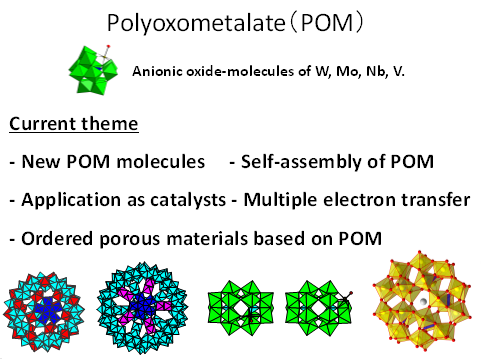Research
Introduction
We are interested in developments of environmentally benign process using novel metal oxide based functional materials such as polyoxometalate and zeolite. We are investigating synthesis, characterization, and application of them.
Currently ongoing researches are
- Polyoxometalate
- Zeolite
Polyoxometalate
Polyoxometalates are anionic metal oxide molecules of W, Mo, Nb, and V as a main metals. Polyoxometalates can incorporate almost all elements in Periodic table and form variety of structure. In addition, polyoxometalates with proton as a counter cation have high acidity and polyoxometalates show multiple redox properties. Therefore, polyoxomelates have attracted much attention as catalysts. Our current researches are 1. Synthesis and characterization of new polyoxometalates, 2. Self-assembly of polyoxometalate to infinite metal oxides, 3. Application of polyoxometalates as catalysts, and 4. Synthesis of ordered porous materials based on polyoxometalates.

Zeolite
On-demand zeolite synthesis
Zeolites are one of the most important crystalline silicates material having micropore (2.0 nm ≥ dP) in industry. Because of their attractive properties (adsorption, catalytic and ion exchange), they are utilized for the environmentally friendly and economically benefit application such as petrochemical industries, oil refineries, fine chemicals industries, and environmental treatment. We are focusing on the on-demand synthesis of zeolite, intentional synthesis of zeolite with desired property. We are investigating crystallization mechanism, detail structural analysis, and catalytic and adsorption application of zeolite. We hope that our scientific findings about such synthesis-crystallization mechanism-structure-function correlation will contribute the innovative progress of future industry and wealthy life. The current project focus are carbon capture and utilization, purification of exhaust gas, and other company collaboration that requires academic knowledge, sample and synthetic technique of zeolite.
